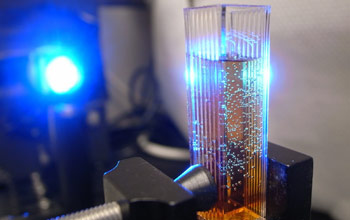Multimedia Gallery
Water oxidation advance boosts potential for solar fuel
Bubbles form during water oxidation, catalyzed by a new tetra-cobalt water oxidation catalyst. The new catalyst, the most effective catalyst so far for water oxidation -- a crucial component in generating hydrogen fuel from water -- was developed by researchers in the lab of Emory University professor of chemistry Craig Hill.
More about this image
The water oxidation catalyst research is a component of the Emory Bio-inspired Renewable Energy Center (EBREC), which aims to mimic natural processes such as photosynthesis to generate clean fuel. The long-term goal is to use sunlight to split water into oxygen and hydrogen. Hydrogen becomes the fuel. Its combustion produces the byproduct of water, which flows back into a clean, green, renewable cycle.
To read more about this research, see the Emory news story Water oxidation advance boosts potential for solar fuel. (Date of Image: 2010)
Credit: Laboratory of Craig L. Hill; photos courtesy of Zhuangqun "Teddy" Huang
See other images like this on your iPhone or iPad download NSF Science Zone on the Apple App Store.
Images and other media in the National Science Foundation Multimedia Gallery are available for use in print and electronic material by NSF employees, members of the media, university staff, teachers and the general public. All media in the gallery are intended for personal, educational and nonprofit/non-commercial use only.
Images credited to the National Science Foundation, a federal agency, are in the public domain. The images were created by employees of the United States Government as part of their official duties or prepared by contractors as "works for hire" for NSF. You may freely use NSF-credited images and, at your discretion, credit NSF with a "Courtesy: National Science Foundation" notation.
Additional information about general usage can be found in Conditions.
Also Available:
Download the high-resolution JPG version of the image. (685 KB)
Use your mouse to right-click (Mac users may need to Ctrl-click) the link above and choose the option that will save the file or target to your computer.



